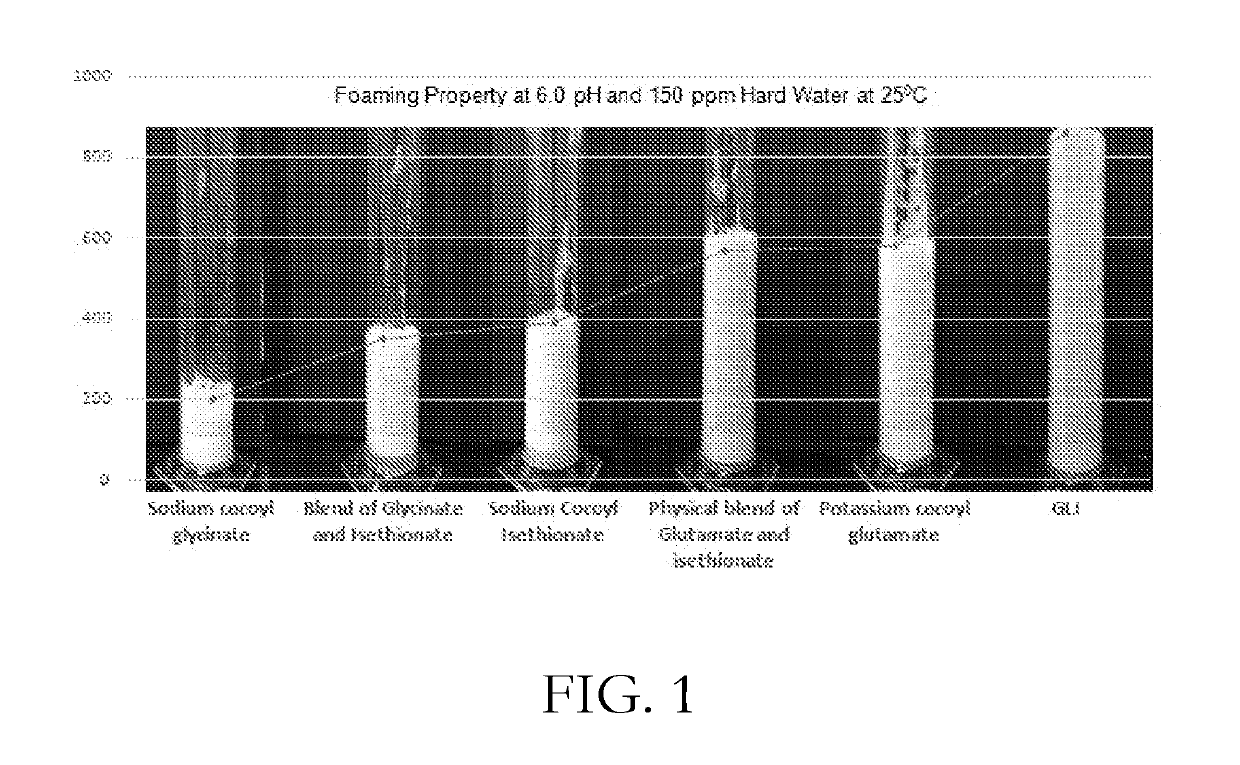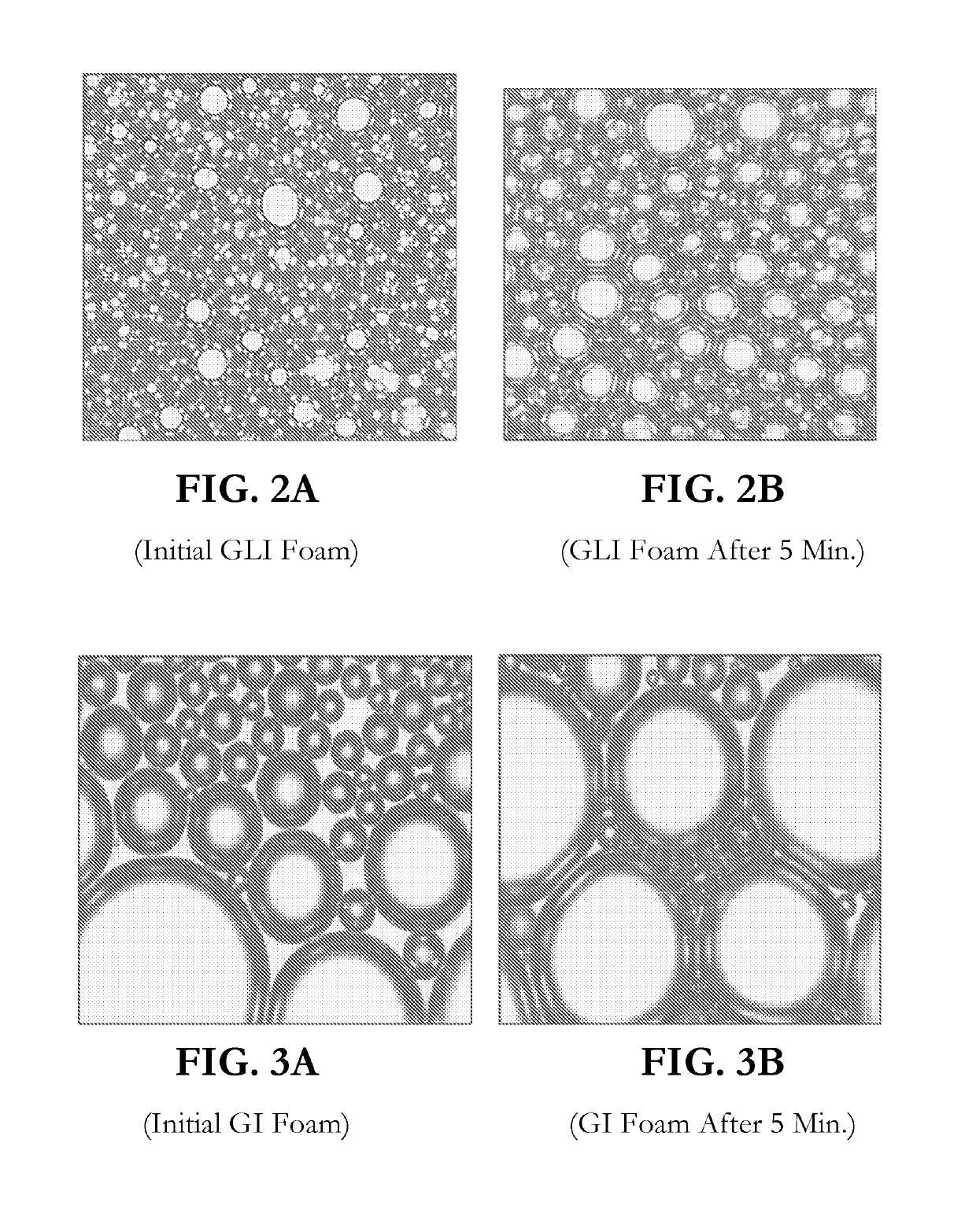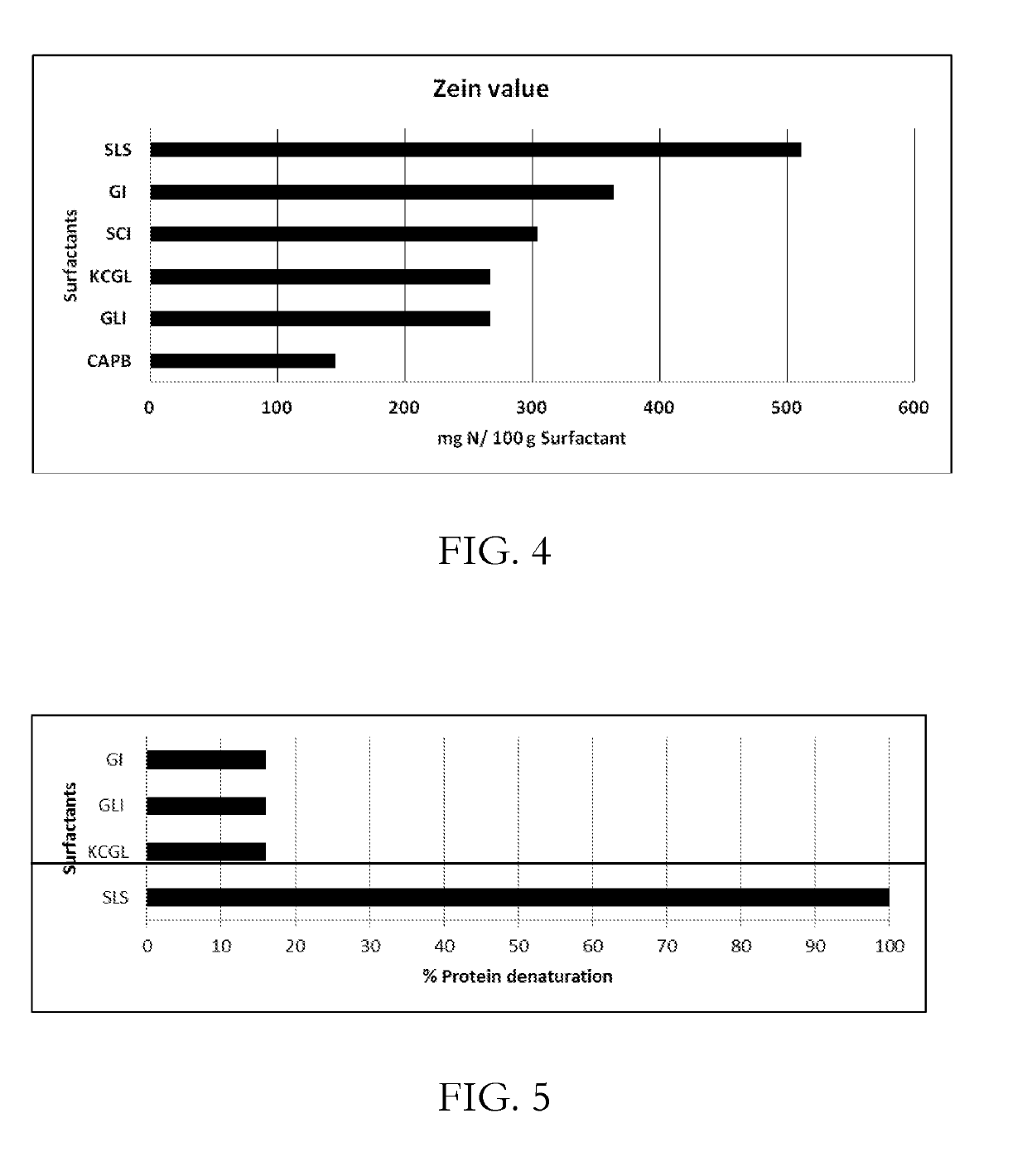CONCENTRATED AND SELF-PRESERVING COMPOSITIONS OF MILD SURFACTANTS FOR TRANSPARENT AND SKIN-pH PERSONAL CARE FORMULATIONS
a technology of surfactants and compositions, applied in the field of concentrated and self-preserving compositions of mild surfactants for transparent and skin-ph personal care formulations, can solve the problems of affecting the function of skin (stratum corneum) to balance moisture, affecting the skin's elasticity, etc., and achieves low viscosity and high active
- Summary
- Abstract
- Description
- Claims
- Application Information
AI Technical Summary
Benefits of technology
Problems solved by technology
Method used
Image
Examples
example 1
[0069]Synthesis of Surfactant Composition of Sodium Cocoyl Isethionate and Mono Potassium Cocoyl Glutamate in Molar Ratio of 1:2 and 1% w / w of Lipoglycines, Undecylenoyl Glycine and Capryloyl Glycine (1:1 w / w).
[0070]The cocoyl chloride used in this experiment had the following alkyl chain distribution C8: 5.0%, C10: 6.0%, C12: 62.6%, C14: 20.0%, C16: 6.0%, C18: 0.4%
[0071]To a stirred cocoyl chloride (328 g, 1.5 gmol) under slow purging of nitrogen at room temperature, sodium isethionate (74 g, 0.5 gmol) was added and the slurry was stirred at 55-60° C. for 4 h. The HCl gas generated was absorbed in alkali solution and the progress of reaction was monitored by IR spectrum analysis. The FTIR spectrum of the intermediate showed the presence of unreacted cocoyl chloride (carbonyl stretch at 1800 cm−1), sodium cocoyl isethionate (carbonyl of ester at 1734 cm−1) and disappearance of hydroxyl stretch (3323 cm−1) of sodium isethionate.
[0072]This fluid viscous reaction mass (380 g) was coole...
example 2
[0074]Synthesis of a Composition of Sodium Lauroyl Isethionate and Mono Potassium Lauroyl Glutamate in Molar Ratio of 1:2 and 1% w / w of Lipoglycines, Undecylenoyl Glycine and Capryloyl Glycine (1:1 w / w).
[0075]To a stirred lauroyl chloride (218.5 g, 1.0 gmol) under slow purging of nitrogen at room temperature, sodium isethionate (49.5 g, 0.333 gmol) was added and the slurry was stirred at 65-70° C. for 4 h. The HCl gas generated was absorbed in alkali solution and the progress of reaction was monitored by IR spectrum analysis. The FTIR spectrum of the intermediate showed the presence of unreacted lauroyl chloride (carbonyl stretch at 1800 cm−1), sodium lauroyl isethionate (carbonyl of ester at 1734 cm−1) and disappearance of hydroxyl stretch (3323 cm−1) of sodium isethionate.
[0076]This fluid viscous reaction mass (255 g) was cooled to room temperature and then added slowly to a stirred aqueous solution of L-glutamic acid (103 g, 0.7 gmol) in water (296 g) along with potassium hydroxi...
example 3
[0078]Synthesis of a Composition of Sodium Cocoyl Isethionate and Sodium Cocoyl Glycinate in Molar Ratio of 1:2 and 1% w / w of Lipoglycines, Undecylenoyl Glycine and Capryloyl Glycine (1:1 w / w).
[0079]The cocoyl chloride used in this experiment had the following alkyl chain distribution C8: 5.0%, C10: 6.0% C12: 62.6% C14: 20.0% C16: 6.0% C18: 0.4% To a stirred cocoyl chloride (234 g, 1.05 gmol) under slow purging of nitrogen at room temperature, sodium isethionate (52 g, 0.35 gmol) was added and the slurry was stirred at 55-60° C. for 4 h. The HCl gas generated was absorbed in alkali solution and the progress of reaction was monitored by IR spectrum analysis. The FTIR spectrum of the intermediate showed the presence of unreacted cocoyl chloride (carbonyl stretch at 1800 cm−1), sodium cocoyl isethionate (carbonyl of ester at 1734 cm−1) and disappearance of hydroxyl stretch (3323 cm−1) of sodium isethionate.
[0080]This fluid viscous reaction mass (270 g) was cooled to room temperature an...
PUM
| Property | Measurement | Unit |
|---|---|---|
| pH | aaaaa | aaaaa |
| pH | aaaaa | aaaaa |
| pH | aaaaa | aaaaa |
Abstract
Description
Claims
Application Information
 Login to View More
Login to View More - R&D
- Intellectual Property
- Life Sciences
- Materials
- Tech Scout
- Unparalleled Data Quality
- Higher Quality Content
- 60% Fewer Hallucinations
Browse by: Latest US Patents, China's latest patents, Technical Efficacy Thesaurus, Application Domain, Technology Topic, Popular Technical Reports.
© 2025 PatSnap. All rights reserved.Legal|Privacy policy|Modern Slavery Act Transparency Statement|Sitemap|About US| Contact US: help@patsnap.com



